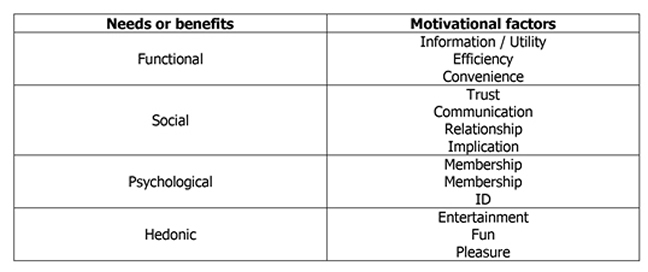
doi.org/10.15198/seeci.2019.48.125-148
RESEARCH
RELATIONSHIP BETWEEN THE BENEFITS AND THE OBTAINING OF ENGAGEMENT OF THE USERS IN THE COMMUNICATION OF THE SOCIAL NETWORKS OF THE HOTEL SECTOR
RELACIÓN ENTRE LOS BENEFICIOS Y LA OBTENCIÓN DE ENGAGEMENT DE LOS USUARIOS EN LA COMUNICACIÓN DE LAS REDES SOCIALES DEL SECTOR HOTELERO
RELAÇÃO ENTRE OS BENEFÍCIOS E A OBTENÇÃO DE ENGAGEMENT DOS USUÁRIOS NA COMUNICAÇÃO DAS REDES SOCIAIS DO SETOR HOTELEIRO
Miguel Ángel Sánchez Jiménez1, María Teresa Fernández Allés1, María Teresa Fernández Allés1
1Cadiz University. Spain.
ABSTRACT
With the growing power of online consumers and the increased penetration of the internet around the world, online brand communities have formed an important communication platform between companies and consumers. These social media have offered consumers the opportunity to share opinions, recommendations and experiences through comments, images or videos with other users, which can be read and commented among them. In this way, this research intends to analyze if the perceived benefits are related to the obtaining of commitment or engagement on the part of the users in the social networks of the hotels. For this, a quantitative analysis has been carried out by means of a questionnaire addressed to the followers of the social networks of hotels or hotel chains. Thus, 4 hypotheses have been proposed to analyze whether the 4 identified benefits (functional, socio-psychological, hedonic and monetary benefits) are directly related to the 4 variables identified in the engagement (user participation, trust, affective commitment and loyalty), being able to contrast so if the benefits perceived by users in these social networks caused an increase in the 4 variables of engagement. The results specify a positive link of the socio-psychological and hedonic benefits perceived by the user with a greater engagement, however, there is more discrepancy in the functional benefits and, above all, to highlight the scarce transcendence of the monetary benefit to achieve a greater commitment with the users.
KEY WORDS: social networks, communication, hotel sector, users, benefits, engagement, questionnaire.
RESUMEN
Con el creciente poder de los consumidores online y la mayor penetración de internet en todo el mundo, las comunidades online de marcas han formado una importante plataforma de comunicación entre las empresas y los consumidores. Estos medios sociales han ofrecido al consumidor la oportunidad de compartir opiniones, recomendaciones y experiencias a través de comentarios, imágenes o videos con otros usuarios, que pueden ser leídos y comentados entre ellos. De esta manera, en esta investigación se pretende analizar si los beneficios percibidos están relacionados con la obtención de compromiso o engagement por parte de los usuarios en las redes sociales de los hoteles. Para ello se ha realizado un análisis cuantitativo mediante un cuestionario dirigido a los seguidores de las redes sociales de hoteles o cadena de hoteles. Así, se han propuesto 4 hipótesis para analizar si los 4 beneficios identificados (beneficio funcional, socio-psicológico, hedónico y monetario) están directamente relacionados con las 4 variables identificadas del engagement (participación del usuario, confianza, compromiso afectivo y lealtad) pudiendo contrastar así si los beneficios percibidos por los usuarios en dichas redes sociales provocado un aumento en las 4 variables del engagement. Los resultados especifican una vinculación positiva de los beneficios sociopsicológicos y hedónicos percibidos por el usuario con un mayor engagement, sin embargo, hay más discrepancia en los beneficios funcionales y, sobre todo, destacar la escasa trascendencia del beneficio monetario para conseguir un mayor compromiso con los usuarios.
PALABRAS CLAVE: redes sociales, comunicación, sector hotelero, usuarios, beneficios, engagement, cuestionario.
RESUME
Com o crescente poder dos consumidores online e a maior penetração de internet em todo o mundo, as comunidades online de marcas formaram uma importante plataforma de comunicação entre as empresas e os consumidores. Esses meios sociais ofereceram ao consumidor a oportunidade de compartir opiniões, recomendações e experiências através de comentários, imagens ou vídeos com outros usuários, que podem ser lidos e comentados entre si. Desta maneira, nesta investigação pretende-se analisar se os benefícios percebidos estão relacionados com a obtenção de compromisso ou engagement por parte dos usuários nas redes sociais dos hotéis. Para isso foi realizado uma analises quantitativa mediante um questionário dirigido aos seguidores das redes sociais de hotéis ou cadeia de hotéis. Assim, propuseram 4 hipóteses para analisar se os 4 benefícios identificados (benefício funcional, sócio psicológico, hedônico e monetário) estão diretamente relacionados com as 4 variáveis identificadas do engagement (participação do usuário, confiança, compromisso afetivo e lealdade) podendo contrastar assim se os benefícios percebidos pelos usuários em tais redes sociais provocaram um aumento nas 4 variáveis do engagement. Os resultados especificam uma vinculação positiva dos benefícios sócio psicológicos e hedônicos percebidos pelo usuário com um maior engagement, embora haver mais discrepância nos benefícios funcionais e, sobretudo, destacar a escassa transcendência do benefício monetário para conseguir um maior compromisso com os usuários.
PALAVRAS CHAVE: redes sociais, comunicação, setor hoteleiro,usuários, benefícios, engagement, questionário.
Correspondence: Miguel Ángel Sánchez Jiménez: Cadiz University. Spain.
miguelangel.sanchez@uca.es
María Teresa Fernández Allés: Cadiz University. Spain.
teresa.alles@uca.es
Juan José Mier-Terán Franco: Cadiz University. Spain.
Juanjose.mier-teran@uca.es
Received: 21/06/2018
Accepted: 12/09/2018
Published: 15/03/2019
1. INTRODUCTION
Social media has offered consumers the opportunity to share opinions, recommendations and experiences through comments, images or videos with other users, which can be read and commented among them. This has led to many tourism companies have launched out to try it and have the opportunity to both analyze the information and communicate with the consumer, giving way to sales promotion with the aim of creating a message focused on the customer (Martinez et al. al., 2013). Thus, social media is changing the way that tourists consume and contribute to the creation of information, assuming a radical alteration in the way information is disseminated (Potgieter and Naidoo, 2017, Rosenthal and Brito, 2017). In addition, experiences related to tourism cannot be valued until they are consumed, since they are intangible, hence social media, with the personal recommendations of users and nearby people, are very influential when taking a decision on tourism choice (Buhalis, 1998; Litvin, et al., 2008).
The characteristics of the tourism sector, in general, and the hotel sector, in particular, make greater its impact on social media. The tourism sector, like any service sector, sells intangible products that are characterized by being inseparable, perishable and heterogeneous (Sirakaya and Woodside, 2005), hence the communication process is a vital element in the offer (Sigala, 2007). For this reason, the use of social media has allowed new communication possibilities and has provided a substantial impact on tourism demand and supply (Martínez et al., 2013).
Sahín and Sengün (2015) specify that comments on social media are important due to the large proportion of users who use the internet to decide their stay. In particular, users who want information about tourist destinations and hotel establishments are influenced to a large extent by comments on social networks, therefore, brand recognition and trust in the establishment depends on these comments. This results in the influence of social media in the hotel sector being high, allowing tourist establishments to get in touch with users and that their actions reach a large number of people in a short period of time and in an efficient manner. (Bambauer-Sachse and Mangold, 2011).
This is especially relevant for hotel companies since they depend to a great extent on the client’s experience, so they should be more concerned with improving engagement or commitment (Dowling, 2001). In this context, consumer engagement has emerged as a dynamic and interactive concept through which to understand the construction of strong, lasting and loyal relationships with customers. The concept of consumer engagement exceeds the individualistic perspective of traditional marketing to provide sellers with a global process that encompasses all activities, based on the brand and its motivation on customers, giving rise to emotional and close ties between the client and the company (Naumann and Lay-Hwa Bowden, 2015).
According to Cruz and Mendelsohn (2010), members of online brand communities are more committed and more likely to buy and recommend the brand to others, compared to non-members. In the same sense, Becerra and Badrinarayanan (2013) determine that members of the online community of a brand contribute to a greater extent to the dissemination of information about that brand. Therefore, it is considered of great interest to understand how users intervene in these online communities of brands and know what the benefits they perceive. In this sense, it is essential to analyze the engagement or commitment of the consumer. Knowing the consumer’s engagement towards a tourist destination adds value to it, since it is based on the increase of interactivity and improvement of the relations with the consumer (Vivek et al., 2014).
In this way, the objective of this study is to analyze whether the perceived benefits are related to obtaining commitment or engagement from users in the social networks of hotels. For this, a quantitative analysis has been carried out by means of a questionnaire addressed to the followers of the social networks of hotels or hotel chains. Thus, 4 hypotheses have been proposed to analyze whether the 4 identified benefits (functional, socio-psychological, hedonic and monetary benefits) are directly related to the 4 variables identified in the engagement (user participation, trust, affective commitment and loyalty), being able to thus contrast if the benefits perceived by users in these social networks caused an increase in the 4 variables of engagement.
2. RESEARCH HYPOTHESIS
In this section, the hypothesis of the investigation, which suppose observable facts that must be empirically tested are presented (Third, 1999).
H1: a greater functional, socio-psychological, hedonic and monetary benefit is associated with greater participation in the hotel’s online community.
H2: a greater functional, socio-psychological, hedonic and monetary benefit is associated with greater confidence towards the hotel.
H3: a greater functional, socio-psychological, hedonic and monetary benefit is associated with a greater affective commitment towards the hotel.
H4: a greater functional, socio-psychological, hedonic and monetary benefit is associated with greater loyalty towards the hotel.
3. THEORETICAL FRAMEWORK
Next, the most relevant studies about the main concepts that have been taken into account in this research are specified: the benefits perceived by the users and the identified engagement variables.
3.1. Functional, psychological, social, hedonic and economic benefits of online communities
Several social theories have explained why people use social networks (in this case, social networks of hotel chains): to obtain information; go shopping; to communicate and interact with others; to have fun and enjoy the experience; to enter into new relationships; and to express their opinions and their identity. From the studies conducted on Kang’s research (2011), Leung et al. (2015), Vivek et al. (2012) and Naumann and Bowden (2015), and observed the opinions of experts in social networks, the main variables under study have been identified and proposed several models to contrast the basic hypotheses that are related to the benefit perceived by the user and consumer commitment.
In various investigations, interest has been shown in knowing the factors that motivate the participation and commitment of users of social networks. Wang and Fesenmaier (2004) proposed a model based on the needs or benefits that users seek to satisfy in virtual communities. According to these authors, participation and commitment are driven by four types of needs or benefits: functional, social, psychological and hedonic. They argue that for virtual communities to be viable they must cater to a variety of needs or benefits of members. In the study by Dholakia et al. (2004) they identified more specific factors that motivate individuals to participate in virtual communities based on intentional action. Madupu (2006) stated that the motives of Dholakia et al. (2004) can be reconciled and related to the benefit categories proposed by Wang and Fesenmaier (2004), thus proposing a set of antecedents for participation and commitment in virtual communities (Table 1).
Table 1. Benefits of participation and commitment in the virtual communities of a brand.

Source: Own elaboration from the works of Madupu (2006), Dholakia et al. (2004) and Wang and Fesenmaier (2004).
In addition to these four variables, the monetary benefits that have been valued by other studies such as the Gwinner et al. (1998) and Lee et al. (2008) will be taken into account. This dimension is related to discounts or company events offered to the community “obtain discounts or special deals that most consumers do not have”, “obtain better prices than most consumers” and “receive free coupons for a stay in the hotel or food to become a member of the Facebook page”.
The functional benefit is understood as the ease in obtaining information relevant to the consumer’s objectives without having temporal or geographical limitations (De Vries and Carlson, 2014), as well as the facility to carry out the pertinent transactions. One of the most visible benefits of social networks is that information is publicly available and easily accessible (Hays and Buhalis, 2013). Some studies (Hiltz and Wellman, 1997) affirm that knowledge and information are a valuable asset for communities. If members can get functional benefits, such as acquiring information quickly, they are more likely to visit the online community (Al-Msallan and Alhaddad, 2016). In any case, the relationship between the functional benefits and the commitment in the community will vary depending on what the users seek to obtain from the community (for example, if they prefer entertainment or acquire information). In the study of Al-Msallan and Alhaddad (2016), the members of the Facebook page of the hotels sought communication with the rest of the members in an efficient way, as well as sharing information about their experiences with hotel brands. To fulfill these wishes, members visited social networks on a frequent basis. According to this study, the functional benefits have a direct influence with the increase of the participation of the members in the Facebook pages.
The perceived social benefits are related to emotional support, friendship or communication with other members (Chen, 2013). Some studies have revealed that virtual communities are places where people seek emotional support and a sense of permanence Furlong, 1989; Hiltz and Wellman, 1997). Four factors of social benefit: belonging, influence and relationship, integration and satisfaction of a need, together with the connection with shared emotions, were used in the study by Kim et al. (2004), verifying that the first three had a direct effect on the purchase intention. This type of benefits derives from the feelings of connection with the members of the community and include the feeling of affiliation with other individuals (Bressler and Grantham, 2000). As a member you get information about the community and you begin to perceive a feeling of belonging to that group, which results in a symbol of identification (Wang and Fesenmaier, 2004).
The significant relationship between psychological benefits and participation in communities is shown in the studies by Ahuja and Galvin (2003), Langerak et al. (2003) and Al-Msallan and Alhaddad (2016). Thus, it is indicated that psychological benefits significantly influence the attitudes of members towards the online community, thy also found a positive relationship between the sense of belonging to a community and loyalty to it. These studies have also proven the positive relationship between psychological benefits and commitment in an online community. Consumers may increase their level of participation to express their preferences, which unites them emotionally to other members of the community.
In the studies of Kang (2011) and Song and Yoo (2016) they establish that the social and psychological benefits have a high correlation between them, therefore, in both studies, both variables were combined in a renamed as “socio-psychological benefit”. Because a high correlation between these two variables has been shown, in this study they have also been combined, resulting in the variable “socio-psychological benefit” which has been studied.
It includes positive emotional states such as fun and enjoyment of the experience when participating in community activities (Wang and Fesenmaier, 2004). In online communities, members can engage in activities that cause them positive emotions such as happiness, excitement or enthusiasm (Dholakia (2004).) Some online communities allow participating in games, contests or conducting surveys, which involve fun and entertainment (Wang and Fesenmaier, 2004).
Consumers expect to obtain an economic advantage from a relationship, understood as a monetary saving (Gwinner et al., 1998). For example, obtaining discounts is one of the reasons why individuals relate to a brand (Harris et al., 2003; Gwinner et al. (1998) showed the importance of monetary benefits when trying to develop a relationship with a services enterprise. As the Al-Msallan and Alhaddad (2016) qualify, the monetary benefits need to be further investigated to determine if they can stimulate potential consumers to join the Facebook pages of the hotels. In short, in their research they show that they do not influence the level of commitment of online communities.
Variables of the engagement: Consumer participation, trust towards the brand, loyalty towards the brand, and affective commitment
The engagement or commitment of the consumer is considered one of the main attractions of the use of social media marketing, therefore, it is considered of interest to relate these variables of the types of benefits with those that are most identified and influence consumer commitment. After a review of the literature, the following variables that affect consumer commitment to the brand have been taken into account: consumer participation in social networks, trust towards the brand, emotional commitment and brand loyalty.
Passive members rarely get involved in community activities. The number of these users generates traffic and increases the visits of the website but does not guarantee the success of the community since they do not contribute to community activities. On the contrary, these types of members tend to pursue their own goals (Al-Msallan and Alhaddad, 2016). Wang and Fesenmaier (2004) showed empirically that hedonic and social needs are positively related to participation while functional benefits have a negative effect. According to these authors, psychological needs have no relation to participation. In the study conducted by Al-Msallan and Alhaddad (2016) a positive relationship was shown between the functional, social, psychological and hedonic benefits with participation in the community. On the contrary, the economic benefits do not have a significant relationship with participation.
Brodie et al. (2011), on the other hand, defines trust based on online communities, understanding as trust that of the members of a community, making the group efficient and resolving the problems that may arise to any of them. One of the objectives of marketing is to gain consumer confidence in the brand, since trust is important during the purchase process (Powers et al., 2012). This importance has an impact on the attitudes and behaviors that consumers adopt towards a brand (Gefen et al., 2003). Online communities are becoming sources of information since travelers have more confidence in the opinions of the rest of the members than in marketing organizations (Gretzel et al., 2008). Therefore, a priori, social and functional benefits will influence the confidence that a consumer has towards a certain brand.
McWilliam (2000) showed the impact of online communities in building lasting relationships between businesses and consumers. These strong relationships reflect the psychological union with the community and the mutual belief in the other (Morgan and Hunt, 1994). Confidence can be improved when members increase their dependence on the internet to obtain information on the products that will help them make purchasing decisions (Shankar et al., 2003). In this way, companies can use online communities, and the benefits inherent therein, to build trust and consequently commitment to their brands (Ulusu, 2010). In addition, if people value the pleasurable and functional benefits of your brand, your confidence in it will increase. (Carroll and Ahuvia, 2006; Zhou et al. (2012).
Affective commitment is defined as “the psychological consequence of an exchange or transaction, based on feelings such as identification, loyalty and affiliation” (Verhoef et al., 2002). This psychological desire attached to the product or brand (Bansal et al., 2004) is a link that motivates the consumer to remain in a relationship with an organization. Johnson and Chang (2006) pointed out that the affective commitment determines the desire of a consumer to continue in a relationship in the future.
Affective commitment has been considered as a potential antecedent of consumer commitment by different researchers (for example, Sashi, 2012, Bowden, 2009). When a consumer feels actively committed to a product or service, it develops behavioral and emotional relationships with the brand (Guevremont and Grohmann, 2013). In addition, the affective commitment has been included in several definitions of consumer commitment. Mollen and Wilson (2010) emphasize that consumer knowledge and affective commitment are useful to maintain an active relationship with the brand personified by the web or by other measures designed to communicate the value of the brand.
The perceived benefits in social networks influence brand loyalty (Algesheimer et al., 2005). This has been defined by Peterson and Carrabis (2008) as the level of long-term interaction that the consumer has with a brand, website or product. These authors include loyalty in an index created to measure the value of consumer commitment. In fact, consumer engagement is seen as a process and not as a state because it is projected onto a variety of consumer behaviors and attitudes that result in positive consequences on the brand, such as loyalty (Verhoef et al., 2010; Bowden, 2009; Hollebeek, 2011). In other words, there are studies that measure consumer commitment and use other apparently similar concepts, such as loyalty (Kidd, 2011, Kandampully et al., 2015 and Roberts and Alpert, 2010). The truth is that consumer commitment includes several types of behaviors that result in brand loyalty (Libai, 2011).
4. METHODOLOGY
In this chapter, the research methodology used to analyze the relationship between the variables presented above has been established. The selection of the Facebook and Twitter pages of the hotels and the approach and completion of the questionnaire have been dealt with in these two points.
4.1. Selection of online communities on Facebook and Twitter
The present study has been carried out through the Facebook and Twitter pages of the hotels or hotel chains from three to five stars. These two social networks have been chosen because they are the most used by companies in the hotel sector (Hmobile, 2015, Beezhotels, 2016). In addition, many Facebook and Twitter pages of hotels have been incorporating several attractive aspects for users who follow them (such as promotions) in order to encourage the participation of members and influence other variables directly related to the commitment of the consumer towards the brand. For the study, the same treatment has been considered if the user answers about the hotel’s Facebook or Twitter, as it was previously specified in the study by Leung et al. (2013) the results obtained between Facebook and Twitter in their use as marketing and communication channels are very similar, what is really important is the use of these social networks, seeking to generate greater benefits through a better experience for users.
4.2. Proposal and completion of the questionnaire
For the construction of the questionnaire, an extensive literature search was carried out on the items that are most suitable for the study, which have been approved by other authors. Afterwards, to validate the questionnaire, a pilot test was carried out to arrive at the final set of questions and determine which are the best items for each construct.
The questionnaire was divided into three sections: (1) Information about the user’s relationship with the social networks of the hotels and the chosen hotel itself and demographic information (2) Functional, socio-psychological, hedonic and monetary benefits; and (3) Participation in the community, trust in the brand, emotional commitment and brand loyalty. Before beginning the first part of the survey, a brief introduction of the study was made, presenting the researcher, briefly determining the topic to be addressed, highlighting the importance of the opinion of the respondents and emphasizing that the data would be treated only anonymously and for research purposes.
Then, Table 2 shows the variables to be analyzed and the items to be measured.
Table 2. Variables and items of quantitative research.
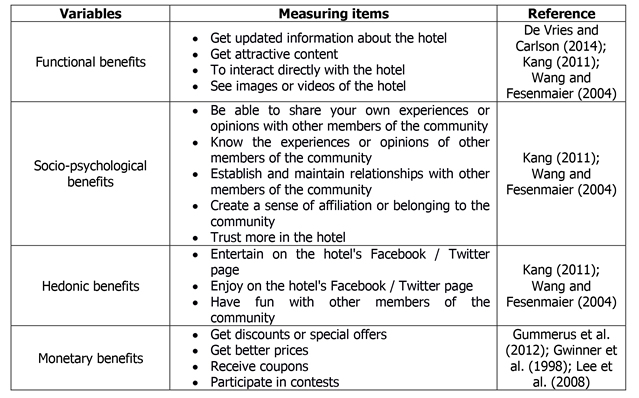
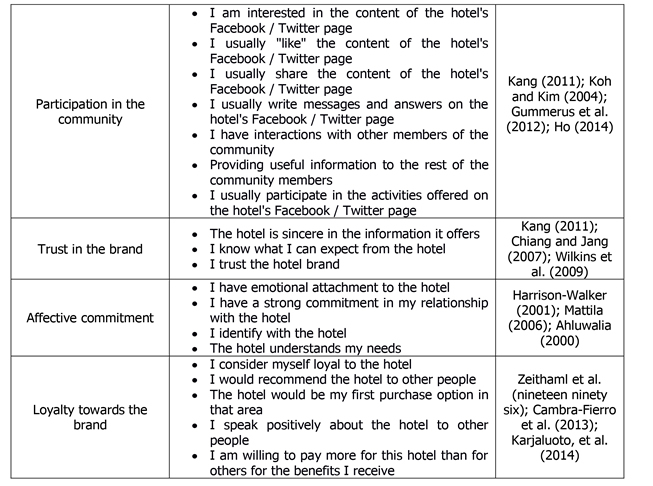
Source: Self made.
4.3. Sample design
Participants were selected by non-probabilistic method of voluntary subjects. The population for the present study is formed by the fans or followers of the Facebook or Twitter pages of hotels. For the development of this research, three or five star hotels that had a presence on Facebook or Twitter with at least 300 followers were requested by e-mail and telephone collaboration, so that they could add the link to the online survey on their social network page. Once counted with the approval of those hotels that agreed to collaborate, they added the link to the online survey on their Facebook or Twitter to make it available to users.
The online survey, being available to the social networks of the hotels and being directed to followers, ensures that this is answered by those users who have been present on said hotel page and have checked its content. Therefore, it has been distributed to users both men and women, at least 18 years of age.
Therefore, the conditions to participate in the study are: have a Facebook or Twitter account, and in turn, follow by Facebook or Twitter a company in the hotel sector. As the survey has been published by the hotels themselves, it facilitates that these conditions are met in all those who participate.
In Table 3, the technical specifications of this quantitative study are specified.
Table 3. Technical sheet of the quantitative study.
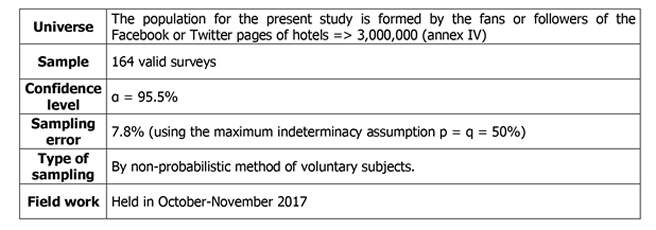
Source: Self made.
5. RESULTS
A total of 164 responses to the questionnaire were obtained, all of them followers of a Facebook or Twitter page of a hotel or hotel chain. For the hypothesis test, the multiple linear regression technique was used. As explained by Moore (2009), regression is a mathematical model that allows predicting the value of a dependent variable (Y) as a function of the values of the independent variable (X). In other words, the values of Y are a function of the values of X.
Next, the results for each of the relationships by the interpretation of the regression coefficients are specified.
5.1. Relationship between benefits and participation
Y = participation
X1 = Functional benefits, X2 = Socio-psychological benefits, X3 = Hedonic benefits, X4 = Monetary benefits
The data in Table 4 confirm what was detected in the correlation analysis, the variable “monetary benefits” is not associated with participation (p = 0.242). It is also discovered that the variable “functional benefits”, which had previously revealed a low but significant correlation with participation, now shows us absence of relationship with this dependent variable (p = 0.436). Therefore, only the variables “socio-psychological benefits” and “hedonic benefits” have a significant contribution to the explanation of participation, the latter being the one with the greatest weight in the explanation of the variability of the dependent variable “participation” (Beta B. Hedonic = 0.516). Specifically, in this model, an increase in a point in the scale of hedonic benefits produces an increase of 1.3341 points in the variable “participation”, when all other types of benefits are equal to 0, that is, they are controlled. On the other hand, an increase of one point in the socio-psychological benefits will produce an increase of 0.510 points in the variable “participation”, keeping the other factors controlled.
Table 4. Coefficientsa (participation and functional, socio-psychological, hedonic and monetary benefits).

Source: Self made.
5.2. Relationship between benefits and trust towards the hotel
Y = Trust
X1 = Functional benefits, X2 = Socio-psychological benefits, X3 = Hedonic benefits, X4 = Monetary benefits
Table 5 verifies that the variables “functional benefits”, “socio-psychological” and “monetary” have a significant contribution in explaining the variability of trust. The monetary benefits are those that have a greater influence on confidence (beta = 0.375), while the socio-psychological benefits have a smaller contribution (beta = 0.170), but significant. The hedonic benefits, however, do not reach the level of significance (p = 0.078), so their impact is not relevant in explaining the variability of confidence.
Specifically, in this model, an increase in one point in the scale of monetary benefits produces an increase of 0.260 points in the variable “confidence”, when all other types of benefits are equal to 0, that is, they are controlled. On the other hand, an increase of one point in the functional benefits will produce an increase of 0.220 points in the variable “confidence”, while an increase of one point in the socio-psychological benefits only produces an increase of 0.100 points in the confidence, maintaining in both cases the other controlled factors.
Table 5. Coefficientsa (trust and functional, socio-psychological, hedonic and monetary benefits).
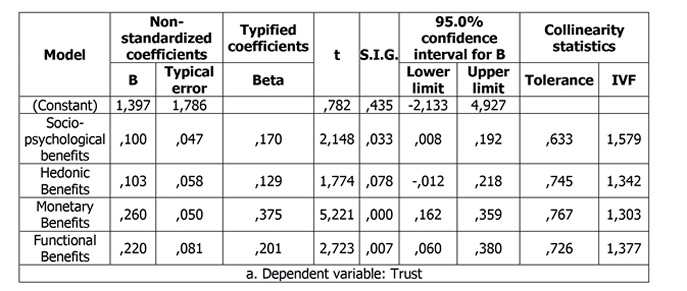
Source: Self made.
5.3. Relationship between the benefits and the affective commitment
Y = Affective commitment
X1 = Functional benefits, X2 = Socio-psychological benefits, X3 = Hedonic benefits, X4 = Monetary benefits
In Table 6 it is verified that they only have a significant contribution to the explanation of the variable “affective commitment”, the socio-psychological benefits and the hedonic benefits.
The hedonic benefits are those that have a greater influence on affective commitment (beta = 0.289) and are followed by socio-psychological benefits (beta = 0.255). The monetary benefits (p = 0.202) and the functional benefits (p = 0.223), on the other hand, do not reach the level of significance, so their impact is not relevant in the explanation of the variability of the affective commitment.
Specifically, in this model, an increase in a point in the scale of hedonic benefits produces an increase of 0,371 points in the variable “affective commitment”, when all other types of benefits are equal to 0, that is, they are controlled. On the other hand, an increase of one point in the socio-psychological benefits will produce an increase of 0.243 points in this dependent variable, maintaining in both cases the other controlled factors.
Table 6. Coefficientsa (affective commitment and functional, socio-psychological, hedonic and monetary benefits).
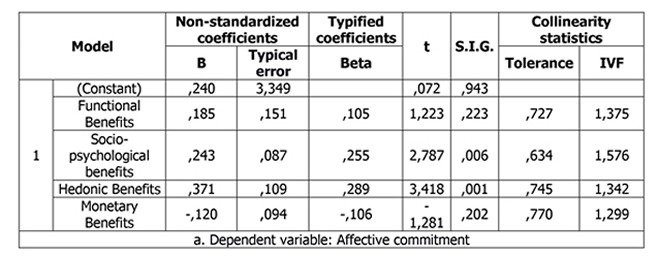
Source: Self made.
5.4. Relationship between the benefits and loyalty to the hotel
Y = Loyalty
X1 = Functional benefits, X2 = Socio-psychological benefits, X3 = Hedonic benefits, X4 = Monetary benefits
In Table 7 it can be verified that the variables “functional benefits”, “socio-psychological” and “monetary” have a significant contribution in explaining the variability of loyalty. The monetary benefits are those that have a greater influence on loyalty (beta = 0.375), while the socio-psychological benefits have a smaller contribution (beta = 0.170), but significant. The hedonic benefits, however, do not reach the level of significance (p = 0.078), so their impact is not relevant in explaining the variability of loyalty.
Specifically, in this model, an increase in a point in the scale of monetary benefits produces an increase of 0, 260 points in the variable “loyalty”, when all other types of benefits are equal to 0, that is, they are controlled. On the other hand, an increase of one point in the functional benefits will produce an increase of 0.220 points in the variable “loyalty”, while an increase of one point in the socio-psychological benefits only produces an increase of 0.100 points in the loyalty, maintaining in both cases the other controlled factors.
Table 7. Coefficientsa (loyalty and functional, socio-psychological, hedonic and monetary benefits).
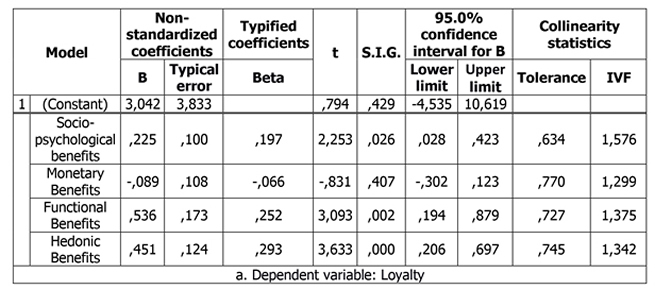
Source: Self made.
6. CONCLUSIONS
In this section, the results derived from the contrast of the hypotheses raised in the study, already discussed in the previous point, are related in summary form in Table 8.
Table 8. Contrast hypothesis in multiple regression models.
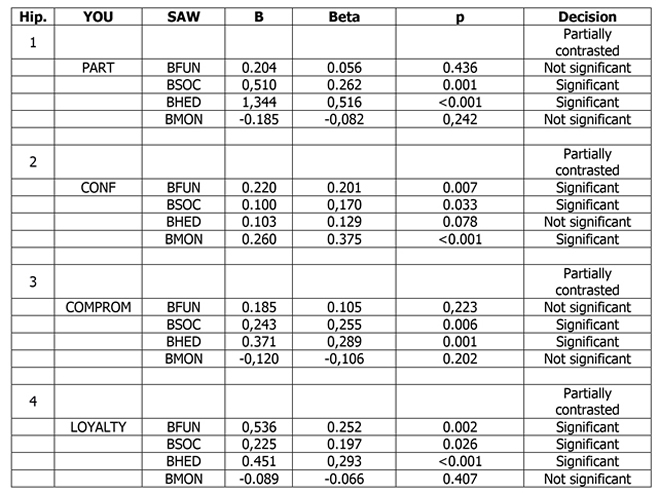
Source: Self made.
Of the four benefits analyzed, only the socio-psychological and hedonic is related to the participation of the consumer, therefore, the user’s participation in the social network will increase the more connection he has with other users and the more entertainment he perceives in said social network. Regarding the relationship between the benefits and the trust towards the hotel, it is verified that both the functional, socio-psychological and monetary benefits positively influence the trust, leaving only the hedonic benefit is excluded. The variable of affective commitment, understood as the emotional bonding to the hotel, only has a positive relationship with the social and hedonic benefits, excluding functional and monetary benefits, which are not related when it comes to achieving a greater emotional bond with the hotel. Finally, a greater perception of functional, social and hedonic benefits will positively influence loyalty to the hotel, leaving excluded only the user’s interest in obtaining economic offers through the monetary benefit. Thus, it is worth mentioning the scarce transcendence of the monetary benefit to achieve a greater commitment with the users.
Therefore, the study determines the implication and the utilities that the users obtain in the social networks of the hotels. In addition, it shows the benefits obtained by users in their intervention in social networks, as well as a greater degree of commitment. In this way, the importance of hotels offering attractive content and oriented to users through social networks is highlighted.
REFERENCES
1. Ahluwalia, R. (2000). Examination of psychological processes underlying resistance to persuasion. Journal of Consumer Research, 27(2), 217-232.
2. Ahuja, M. K., & Galvin, J. E. (2003). Socialization in virtual groups. Journal of Management, 29(2), 161-185.
3. Al-Msallam, S., & Alhaddad, A. (2016). The effects of social media Marketing in the hotel industry: conceptual model for development of an effective online community. International Journal of Business and Management, 5.
4. Algesheimer, R.; Dholakia, U. M., & Herrmann, A. (2005). The social influence of brand community: Evidence from European car clubs. Journal of marketing, 69(3), 19-34.
5. Bambauer-Sachse, S., & Mangold, S. (2011). Brand equity dilution through negative online word-of-mouth communication. Journal of Retailing and Consumer Services, 18(1), 38-45.
6. Bansal, H. S.; Irving, P. G., & Taylor, S. F. (2004). A three-component model of customer to service providers. Journal of the Academy of marketing Science, 32(3), 234-250.
7. Becerra, E., & Badrinarayanan, V. (2013). The influence of brand trust and brand identification on brand evangelism. Journal of Product & Brand Management, 22(5-6), 371-383.
8. Beezhotels (2016). Top 5 de redes sociales para hoteles. Recuperado de: http://www.beezhotels.com/blog/top-5-de-redes-sociales-para-hoteles
9. Bowden, J. (2009). Customer engagement: a framework for assessing customer-brand relationships: the case of the restaurant industry. Journal of Hospitality Marketing & Management, 18(6), 574-596.
10. Bressler, S. E., & Grantham, C. (2000). Communities of commerce: Building internet business communities to accelerate growth, minimize risk, and increase customer loyalty. McGraw-Hill Professional.
11.Brodie Roderick, J., & Linda D. Hollebeek (2011). Advancing and Consolidating Knowledge About Customer Engagement. Journal of Service Research, 14(3), 283-284.
12. Buhalis, D. (1998). Strategic uses of information technologies in the tourism industry. Tourism Management, 19(5), 409-421.
13. Cambra-Fierro, J. J.; Melero-Polo, I., & Vázquez-Carrasco, R. (2013). Customer engagement: Innovation in non-technical marketing processes. Innovation, 15(3), 326-336.
14. Carroll, B. A., & Ahuvia, A. C. (2006). Some antecedents and outcomes of brand love. Marketing letters, 17(2), 79-89.
15. Chen, R. (2013). Member use of social networking sites—an empirical examination. Decision Support Systems, 54(3), 1219-1227.
16. Chiang, C. F., & Jang, S. S. (2007). The effects of perceived price and brand image on value and purchase intention: Leisure travelers’ attitudes toward online hotel booking. Journal of Hospitality & Leisure Marketing, 15(3), 49-69.
17. Cruz, B., & Mendelsohn, J. (2010). Why social media matters to
18. your business. Recuperado de: http://www.cmbinfo.com/cmb-cms/wp-content/uploads/2010/04/Why_Social_Media_Matters_2010.pdf
19. De Vries, N. J., & Carlson, J. (2014). Examining the drivers and brand performance implications of customer engagement with brands in the social media environment. Journal of Brand Management, 21(6), 495-515.
20. Dholakia, U. M.; Bagozzi, R. P., & Pearo, L. K. (2004). A social influence model of consumer participation in network-and small-group-based virtual communities. International journal of research in marketing, 21(3), 241-263.
21. Dowling, G. (2001). Creating Corporate Reputations. Identity, Image, and Performance. Oxford: Oxford University Press.
22. Furlong, M. S. (1989). An electronic community for older adults: The SeniorNet network. Journal of Communication, 39(3), 145-153.
23. Gefen, D.; Karahanna, E., & Straub, D. W. (2003). Trust and TAM in online shopping: an integrated model. MIS quarterly, 27(1), 51-90.
24. Gretzel, U.; Kang, M., & Lee, W. J. (2008). Differences in Consumer-Generated Media Adoption and Use: A Cross-National Perspective. Journal of Hospitality and Leisure Marketing, 17(1-2), 99-120.
25. Guevremont, A., & Grohmann, B. (2013). The impact of brand personality on consumer responses to persuasion attempts. Journal of Brand Management, 20(6), 518-530.
26. Gummerus, J.; Liljander, V.; Weman, E., & Pihlström, M. (2012). Customer engagement in a Facebook brand community. Management Research Review, 35(9), 857-877.
27. Gwinner, K. P.; Gremler, D. D., & Bitner, M. J. (1998). Relational benefits in services industries: the customer’s perspective. Journal of the academy of marketing science, 26(2), 101-114.
28. Harrison-Walker, L. J. (2001). The measurement of word-of-mouth communication and an investigation of service quality and customer commitment as potential antecedents. Journal of service research, 4(1), 60-75.
29. Hays, S.; Page, S. J., & Buhalis, D. (2013). Social media as a destination marketing tool: its use by national tourism organisations. Current issues in Tourism, 16(3), 211-239.
30. Hiltz, S. R., & Wellman, B. (1997). Asynchronous learning networks as a virtual classroom. Communications of the ACM, 40(9), 44-49.
31. Hmobile (2015). El impacto de las redes sociales en el sector hotelero. Recuperado de http://www.hmobile.es/2015/06/15/el-impacto-de-las-redes-sociales-en-el-sector-hotelero/
32. Ho, C. W. (2014). Consumer behavior on Facebook: does consumer participation bring positive consumer evaluation of the brand? EuroMed Journal of Business, 9(3), 252-267.
33. Hollebeek, L. (2011). Demystifying customer engagement: exploring the loyalty nexus. Journal of Marketing Management, 27(7-8), 785-807.
34. Johnson, R. E., & Chang, C. H. (2006). It is to continuance as “We” is to affective: the relevance of the self-concept for organizational commitment. Journal of Organizational Behavior, 27(5), 549-570.
35. Kandampully, J.; Zhang, T., & Bilgihan, A. (2015). Customer loyalty: a review and future directions with a special focus on the hospitality industry. International Journal of Contemporary Hospitality Management, 27(3), 379-414.
36. Kang, J. (2011). Social media marketing in the hospitality industry: the role of benefits in increasing brand community participation and the impact of participation on consumer trust and commitment toward hotel and restaurant brands. Graduate Theses and Dissertations. 10447. https://lib.dr.iastate.edu/etd/10447
37. Karjaluoto, H.; Munnukka, J., & Tikkanen, A. (2014). Are Facebook Brand Community Members Really Loyal to the Brand? 27th Bled eConference eEcosystems, 169-180.
38. Kidd, J. (2011). Enacting engagement online: framing social media use for the museum. Information Technology & People, 24(1), 64-77.
39. Kim, W. G.; Lee, C., & Hiemstra, S. J. (2004). Effects of an online virtual community on customer loyalty and travel product purchases. Tourism management, 25(3), 343-355.
40. Koh, J., & Kim, Y. G. (2004). Knowledge sharing in virtual communities: an e-business perspective. Expert systems with applications, 26(2), 155-166.
41. Langerak, F.; Verhoef, P. C.; Verlegh, P. W., & de Valck, K. (2003). The effect of members satisfaction with a virtual community on member participation. ERIM Report Series Reference No. ERS-2003-004-MKT. Available at SSRN: https://ssrn.com/abstract=411641
42. Lee, Y. K.; Ahn, W. K., & Kim, K. (2008). A study on the moderating role of alternative attractiveness in the relationship between relational benefits and customer loyalty. International Journal of hospitality & tourism administration, 9(1), 52-70.
43. Leung, D.; Law, R.; van Hoof, H., & Buhalis, D. (2013). Social media in tourism and hospitality: A literature review. Journal of Travel & Tourism marketing, 30(1-2), 3.
44. Leung, X. Y., Bai, B. y Stahura, K. A. (2015). The marketing effectiveness of social media in the hotel industry: A comparison of Facebook and Twitter. Journal of Hospitality & Tourism Research, 39(2), 147-169.
45. Libai, B. (2011). Comment: the perils of focusing on highly engaged customers. Journal of Service Research, 14(3), 275-276.
46. Litvin, S. W.; Goldsmith, R. E., & Pan, B. (2008). Electronic word-of-mouth in hospitality and tourism management. Tourism Management, 29(3), 458-468.
47. Madupu, V. (2006). Online brand community participation: antecedents and consequences, Doctoral dissertation.
48. Martínez, S. M.; Bernal García, J. J., & Mellinas, J. P. (2013). Análisis del nivel de presencia de los establecimientos hoteleros de la Región de Murcia en la Web 2.0. Cuadernos de Turismo, 31, 245-261.
49. Mattila, A. S. (2006). How affective commitment boosts guest loyalty (and promotes frequent-guest programs). Cornell Hotel and Restaurant Administration Quarterly, 47(2), 174-181.
50. McWilliam, G. (2000). Building stronger brands through online communities. Sloan management review, 41(3), 43.
51. Mollen, A., & Wilson, H. (2010). Engagement, telepresence and interactivity in online consumer experience: Reconciling scholastic and managerial perspectives. Journal of business research, 63(9), 919-925.
52. Moore, D. S. (2005). Estadística aplicada básica. Antoni Bosch editor.
53. Morgan, R. M., & Hunt, S. D. (1994). The commitment-trust theory of relationship marketing”. The journal of marketing, 20-38.
54. Naumann, K., & Lay-Hwa Bowden, J. (2015). Exploring the process of customer engagement, self-brand connections and loyalty. Problems and perspectives in management, 13, 56-66 and 5.
55. Peterson, E. T, & Carrabis, J. (2008). Measuring the immeasurable: Visitor engagement. Web Analytics Demystified, 14, 16.
56. Potgieter, L. M., & Naidoo, R. (2017). Factors explaining user loyalty in a social media-based brand community. South African Journal of Information Management, 19(1), 1-9.
57. Powers, T.; Advincula, D.; Austin, M. S.; Graiko, S., & Snyder, J. (2012). Digital and social media in the purchase decision process. Journal of advertising research, 52(4), 479-489.
58. Roberts, C., & Alpert, F. (2010). Total customer engagement: designing and aligning key strategic elements to achieve growth. Journal of Product & Brand Management, 19(3), 198-209.
59. Rosenthal, B., & Brito, E. P. (2017). How virtual brand community traces may increase fan engagement in brand pages. Business Horizons, 60(3), 375-384.
60. Sahin, G. G., & Sengün, G. (2015). The Effects of Social Media on Tourism Marketing: A Study among University Students. Management and Administrative Sciences Review, 4(5), 772-786.
61. Sashi, C. M. (2012). Customer engagement, buyer-seller relationships, and social media. Management decision, 50(2), 253-272.
62. Sigala, M. (2007). Web 2.0 in the tourism industry: A new tourism generation and new ebusiness models. Recuperado de http://www.traveldailynews.com/pages/show_page/20554
63. Sirakaya, E., & A. Woodside (2005). Building and testing theories of decision making by travelers. Tourism Management, 26(6), 815-832.
64. Song, S., & Yoo, M. (2016). The role of social media during the pre-purchasing stage. Journal of Hospitality and Tourism Technology, 7(1), 84-99.
65. Tercero, M. M. (1999). Ciencia y marketing: manual para investigadores y doctorandos en ciencias sociales. Esic Editorial.
66. Ulusu, Y. (2010). Determinant factors of time spent on facebook: Brand community engagement and usage types. Journal of Yasar University, 18(5), 2949-2957.
67. Verhoef, P. C.; Franses, P. H., & Hoekstra, J. C. (2002). The effect of relational constructs on customer referrals and number of services purchased from a multiservice provider: does age of relationship matter? Journal of the Academy of Marketing Science, 30(3), 202-216.
68. Verhoef, P. C.; Reinartz, W. J., & Krafft, M. (2010). Customer engagement as a new perspective in customer management. Journal of Service Research, 13(3), 247-252.
69. Vivek, S.; Beatty, S., & Morgan, R., (2012). Customer engagement: Exploring customer relationships beyond purchase. Journal of Marketing Theory and Practice, 20(2), 122-146.
70. Vivek, S.; Beatty, S., & Morgan, R., (2012). Customer engagement: Exploring customer relationships beyond purchase. Journal of Marketing Theory and Practice, 20(2), 122-146.
71. Wang, Y., & Fesenmaier, D. R. (2004). Towards understanding members’ general participation in and active contribution to an online travel community. Tourism management, 25(6), 709-722.
72. Wilkins, H.; Merrilees, B., & Herington, C. (2009). The determinants of loyalty in hotels. Journal of Hospitality Marketing & Management, 19(1), 1-21.
73. Zeithaml, V. A., Berry, L. L. y Parasuraman, A. (1996). “The behavioral consequences of service quality”. The Journal of Marketing, 31-46.
74. Zhou, Z.; Zhang, Q.; Su, C., & Zhou, N. (2012). How do brand communities generate brand relationships? Intermediate mechanisms”. Journal of Business Research, 65(7), 890-895.
AUTHORS
Miguel Ángel Sánchez Jiménez: Teaching staff and Researcher at the University of Cádiz in the Marketing and Communication department. Doctor in Marketing and Communication with the mention of “European Doctorate” and member of the Research Institute for Sustainable Social Development (INDESS). Research activity oriented to new digital technologies in marketing and communication, social media, mobile marketing, tourism, etc. Author of articles published in indexed journals and participation in research congresses.
miguelangel.sanchez@uca.es
Orcid ID: https://orcid.org/0000-0002-4271-3522
María Teresa Fernández Allés: Teaching staff and Researcher at the University of Cádiz in the Marketing and Communication department. PhD in Economics Full Professor at the University. Researcher in the field of marketing and tourism, with specialization in accessible tourism, tourism marketing, tourism sustainability, etc. Professor in the Degree in Business Administration and Management and in the Masters in Business Management, Management of Tourism Companies and Digital and Social Marketing.
teresa.alles@uca.es
Orcid ID: https://orcid.org/0000-0002-3999-8790
Juan José Mier-Terán Franco: Teaching staff and Researcher at the University of Cádiz in the Marketing and Communication department. Professor of University, researcher in the field of social and digital marketing, director of the Department of Marketing and Communication of the University of Cádiz, coordinator of the Master of Management of Digital and Social Marketing and vice president of the International Association of Public Marketing and No Lucrative.
Juanjose.mier-teran@uca.es
Orcid ID: https://orcid.org/0000-0002-6866-1361